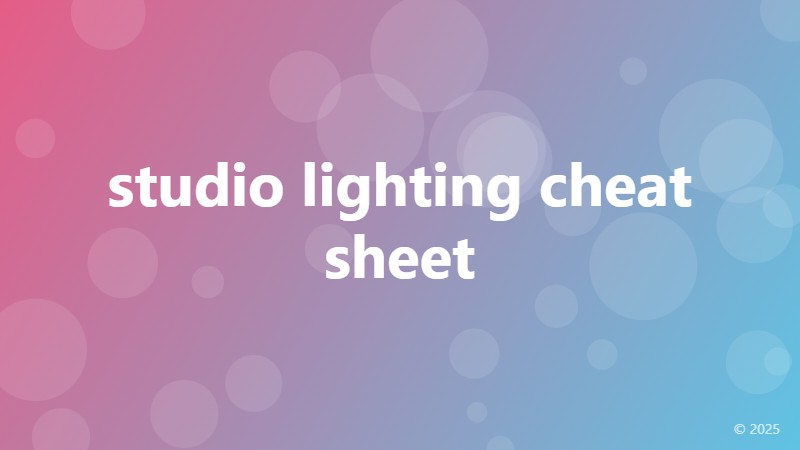studio lighting cheat sheet

Understanding Studio Lighting: A Beginner's Cheat Sheet
Studio lighting can be intimidating, especially for those new to photography. With so many options and techniques to master, it's easy to feel overwhelmed. But fear not! This cheat sheet is designed to break down the basics of studio lighting, providing a solid foundation for beginners to build upon.
Key Concepts: Understanding Light
Before diving into studio lighting, it's essential to understand the fundamental properties of light:
Direction: The direction of light refers to the angle at which it hits your subject. This can greatly impact the mood and depth of your image.
Intensity: The intensity of light refers to its brightness. Adjusting intensity can help achieve the desired effect, from subtle to dramatic.
Color Temperature: Color temperature measures the warmth or coolness of light, ranging from warm (yellow) to cool (blue). This affects the overall mood and atmosphere of your image.
Studio Lighting Essentials: Gear and Equipment
A well-stocked studio should include the following essentials:
Light Sources: Start with a primary light source, such as a strobe or continuous light. Add secondary lights to create depth and dimension.
Modifiers: Softboxes, umbrellas, and reflectors help shape and soften light. Experiment with different modifiers to achieve the desired effect.
Light Stands and Booms: These allow for precise control over light placement and direction.
Common Studio Lighting Setups
Mastering these fundamental setups will help you tackle a variety of photography genres:
Single-Light Setup: Ideal for portraits and product photography, this setup uses a single primary light source.
Two-Light Setup: Adds a secondary light to create depth and dimension, commonly used in fashion and beauty photography.
Three-Point Lighting: Incorporates a key light, fill light, and backlight for a more dramatic, three-dimensional effect.
Tips and Tricks for Studio Lighting Success
Remember these expert tips to elevate your studio lighting skills:
Experiment and Practice: Don't be afraid to try new techniques and lighting setups.
Pay Attention to Ratios: Balance light intensity to achieve the desired mood and effect.
Work with Your Subject: Communicate with your model or subject to capture the desired expression and pose.
By mastering the basics of studio lighting, you'll be well on your way to creating stunning, professional-grade images that capture the essence of your subject. Happy shooting!